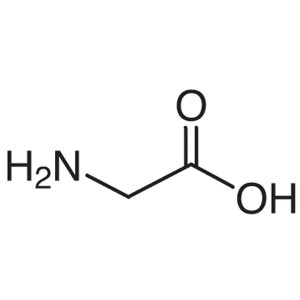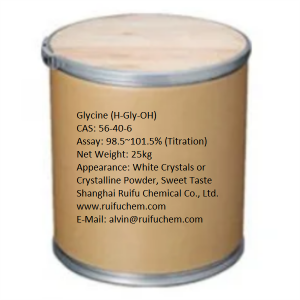Glycine CAS 56-40-6 (H-Gly-OH) Assay 98.5~101.5% Factory High Quality
Shanghai Ruifu Chemical Co., Ltd. is the leading manufacturer and supplier of Glycine (H-Gly-OH) (CAS: 56-40-6) with high quality, production capacity 80000 Tons per year. As one of the largest amino acids suppliers in China, Ruifu Chemical manufactures qualified amino acids and derivatives up to international standards, such as AJI, USP, EP, JP and FCC standard. We can provide COA, worldwide delivery, small and bulk quantities available. If you are interested in Glycine, Please contact: alvin@ruifuchem.com
| Chemical Name | Glycine |
| Synonyms | H-Gly-OH; Abbreviated Gly or G; Aminoacetic Acid; Glycocoll; 2-Aminoacetic Acid; Glicoamin; Glycolixir |
| Stock Status | In Stock, Production Capacity 80000 Tons per Year |
| CAS Number | 56-40-6 |
| Molecular Formula | C2H5NO2 |
| Molecular Weight | 75.07 |
| Melting Point | 240℃(dec.) (lit.) |
| Water Solubility | Soluble in Water, 250 g/l 25℃ |
| Solubility | Practically Insoluble in Ethanol and in Ether. Slightly Soluble in Acetone |
| Storage Temp. | Sealed in Dry, Store at Room Temperature |
| COA & MSDS | Available |
| Classification | Amino Acids and Derivatives |
| Brand | Ruifu Chemical |
| Risk Statements | 33 - Danger of cumulative effects | ||
| Safety Statements | S22 - Do not breathe dust. S24/25 - Avoid contact with skin and eyes. | ||
| WGK Germany | 2 | RTECS | MB7600000 |
| TSCA | Yes | HS Code | 2922491990 |
| Toxicity | LD50 orally in Rabbit: 7930 mg/kg | ||
| Items | Inspection Standards | Results |
| Appearance | White Crystals or Crystalline Powder | Conforms |
| Odor & Taste | Odorless, Having a Sweet Taste | Conforms |
| Identification | Infrared Absorption Spectrum | Conforms |
| Transmittance | ≥98.0% | 99.3% |
| Chloride (Cl) | ≤0.007% | <0.007% |
| Sulfate (SO4) | ≤0.0065% | <0.0065% |
| Ammonium (NH4) | ≤0.010% | <0.010% |
| Iron (Fe) | ≤10ppm | <10ppm |
| Heavy Metals (Pb) | ≤10ppm | <10ppm |
| Arsenic (As2O3) | ≤1.0ppm | <1.0ppm |
| Other Amino Acids | Chromatographically Not Detectable | Conforms |
| Loss on Drying | ≤0.20% (105℃ for 3 hours) | 0.09% |
| Residue on Ignition (Sulfated) | ≤0.10% | 0.07% |
| Hydrolyzable Substances | Meet the Requirements | Conforms |
| Organic Volatile Impurities | Meet the Requirements | Conforms |
| Dioxin | <0.1 pg/g | <0.1 pg/g |
| Assay (C2H5N02) | 98.5 to 101.5% (on Dried Basis) | 99.7% |
| pH Value | 5.5 to 6.5 (5% in Water) | 6.16 |
| Origin | Non-Animal Source | Conforms |
| Conclusion | Accords with the Standard of AJI97; USP35; EP | |
USP35-NF30
DEFINITION
Glycine contains NLT 98.5% and NMT 101.5% of glycine (C2H5NO2), calculated on the dried basis.
IDENTIFICATION
A. INFRARED ABSORPTION <197M>
ASSAY
• PROCEDURE
Sample: 150 mg of Glycine
Blank: 100 mL of glacial acetic acid
Titrimetric system
(See Titrimetry <541>.)
Mode: Direct titration
Titrant: 0.1 N per chloric acid VS
Endpoint detection: Visual
Analysis: Dissolve the Sample in 100 mL of glacial acetic acid, and add 1 drop of crystal violet TS. Titrate with the Titrant to a green endpoint. Perform the Blank determination.
Calculate the percentage of glycine (C2H5NO2) in the Sample taken:
Result = {[(VS − VB) × N × F]/W} × 100
VS = Titrant volume consumed by the Sample (mL)
VB = Titrant volume consumed by the Blank (mL)
N = actual normality of the Titrant (mEq/mL)
F = equivalency factor, 75.07 mg/mEq
W = Sample weight (mg)
Acceptance criteria: 98.5%-101.5% on the dried basis
IMPURITIES
• RESIDUE ON IGNITION <281>: NMT 0.1%
• CHLORIDE AND SULFATE, Chloride <221>
Standard solution: 0.10 mL of 0.020 N hydrochloric acid
Sample: 1 g of Glycine
Acceptance criteria: NMT 0.007%
• CHLORIDE AND SULFATE, Sulfate <221>
Standard solution: 0.20 mL of 0.020 N sulfuric acid
Sample: 3 g of Glycine
Acceptance criteria: NMT 0.0065%
• HEAVY METALS, Method I <231>: NMT 20 ppm
• HEAVY METALS, Method I <231>: NMT 20 ppm
Sample solution: 100 mg/mL of Glycine
Analysis: Boil 10 mL of the Sample solution for 1 min, and set aside for 2 h.
Acceptance criteria: The solution appears as clear and as mobile as 10 mL of the same solution that has not been boiled.
SPECIFIC TESTS
• LOSS ON DRYING <731>: Dry a sample at 105° for 2 h: it loses NMT 0.2% of its weight.
ADDITIONAL REQUIREMENTS
• PACKAGING AND STORAGE: Preserve in well-closed containers.
• USP REFERENCE STANDARDS <11>
USP Glycine RS
Japanese Pharmacopoeia JP17
Glycine, when dried, contains not less than 98.5% of Glycine(C2H5NO2).
Description Glycine occurs as white, crystals orcrystalline powder. It has a sweet taste. It is freely soluble in water and in formic acid, and practically insoluble in ethanol (95). It shows crystal polymorphism.
Identification Determine the infrared absorption spectrum of Glycine, previously dried, as directed in the potassiumbromide disk method under Infrared Spectrophotometry <2.25>, and compare the spectrum with the Reference Spec-trum: both spectra exhibit similar intensities of absorption atthe same wave numbers. If any difference appears between the spectra, dissolve Glycine in water, evaporate the water todryness, and repeat the test with the residue.
pH <2.54> Dissolve 1.0 g of Glycine in 20 mL of water: thepH of the solution is between 5.6 and 6.6.
Purity
(1) Clarity and color of solution-Dissolve 1.0 gof Glycine in 10 mL of water: the solution is clear and color-less.
(2) Chloride <1.03>-Perform the test with 0.5 g of Glycine. Prepare the control solution with 0.30 mL of 0.01mol/L hydrochloric acid VS (not more than 0.021%)
(3) Sulfate <1.14>-Perform the test with 0.6 g of Glycine. Prepare the control solution with 0.35 mL of 0.005mol/L sulfuric acid VS (not more than 0.028z).
(4) Ammonium <1.02>-Perform the test using 0.25 g of Glycine. Prepare the control solution with 5.0 mL of Standard Ammonium Solution (not more than 0.02%).
(5) Heavy Metals <1.07>-Proceed with 1.0 g of Glycine according to Method 1, and perform the test. Prepare the control solution with 2.0 mL of Standard Lead Solution (notmore than 20 ppm).
(6) Arsenic <1.11>-Prepare the test solution with 1.0 gof Glycine according to Method 1, and perform the test (notmore than 2 ppm).
(7) Related Substences-Dissolve 0.10 g of Glycine in 25mL of water and use this solution as the sample solution. Pipet 1 mL of the sample solution, add water to make exactly 50 mL. Pipet 5 mL of this solution, add water to makeexactly 20 mL, and use this solution as the standard solution.Perform the test with these solutions as directed under Thin-layer Chromatography<2.03>. Spot 5mL each of the sample solution and standard solution on a plate of silica gel forthin-layer chromatography. Develop the plate with a mixture of 1-butanol, water and acetic acid (100) (3:1:1) to a distance of about 10 cm, and dry the plate at 80℃ for 30 minutes. Spray evenly a solution of ninhydrin in acetone (1 in 50), andheat at 80℃ for 5 minutes: the spots other than the principal spot from the sample solution are not more intense than the spot from the standard solution.
Loss on Drying <2.41> Not more than 0.30% (1 g, 105℃, 3 hours).
Residue on Ignition <2.44> Not more than 0.10% (1g).
Assay Weigh accurately about 80 mg of Glycine, previously dried, dissolve in 3 mL of formic acid, add 50 mL of acetic acid (100), and titrate <2.50> with 0.1 mol/L perchloric acid VS (potentiometric titration). Perform a blank determi-nation, and make any necessary correction.
Each mL of 0.1 mol/L perchloric acid VS=7.507 mg of C2H5NO2
Containers and storage Containers-Well-closed containers.
Package: Fluorinated Bottle, 25kg/bag, 25kg/Cardboard Drum, or according to customer's requirement.
Storage Condition: Store in sealed containers at cool, dry and ventilated warehouse away from incompatible substances. Protect from light and moisture.
How to Purchase? Please contact Dr. Alvin Huang: sales@ruifuchem.com or alvin@ruifuchem.com
15 Years Experience? We have more than 15 years of experience in the manufacture and export of a wide range of high quality pharmaceutical intermediates or fine chemicals.
Main Markets? Sell to domestic market, North America, Europe, India, Korea, Japanese, Australia, etc.
Advantages? Superior quality, affordable price, professional services and technical support, fast delivery.
Quality Assurance? Strict quality control system. Professional equipment for analysis include NMR, LC-MS, GC, HPLC, ICP-MS, UV, IR, OR, K.F, ROI, LOD, MP, Clarity, Solubility, Microbial limit test, etc.
Samples? Most products provide free samples for quality evaluation, shipping cost should be paid by customers.
Factory Audit? Factory audit welcome. Please make an appointment in advance.
MOQ? No MOQ. Small order is acceptable.
Delivery Time? If within stock, three days delivery guaranteed.
Transportation? By Express (FedEx, DHL), by Air, by Sea.
Documents? After sales service: COA, MOA, ROS, MSDS, etc. can be provided.
Custom Synthesis? Can provide custom synthesis services to best fit your research needs.
Payment Terms? Proforma invoice will be sent first after confirmation of order, enclosed our bank information. Payment by T/T (Telex Transfer), PayPal, Western Union, etc.
Glycine (H-Gly-OH) (CAS: 56-40-6) is of the simplest structure in the 20 members of amino acid series, also known as amino acetate. It is a non-essential amino acid for the human body and contains both acidic and basic functional group inside its molecule. Used for the pharmaceutical industry, organic synthesis and biochemical analysis. Used as a buffer for the preparation of tissue culture media and the testing of copper, gold and silver. In medicine, it is used for the treatment of myasthenia gravis and progressive muscular atrophy, hyperacidity, chronic enteritis, and children hyperprolinemia diseases, using in combination with aspirin can reduce the irritation of the stomach; treatment of children hyperprolinemia; as the nitrogen source for generating non-essential amino acid and can be added to a mixed amino acid injection. Glycine is primarily used as a nutritional additive in chicken feed. Used as a kind of nutritional supplement which is mainly used for flavoring. Flavoring agent: Used for alcoholic beverage in combination with alanine; In pharmacy, it is used as antacids (hyperacidity), therapeutic agent for muscle nutritional disorder as well as antidotes. Moreover, glycine can also be used as the raw material for synthesizing amino acids like threonine. It can be used as a spice according to the provisions of GB 2760-96. In the field of pesticide production, it is used for synthesizing the glycine ethyl ester hydrochloride which is the intermediate for the synthesis of pyrethroid insecticides. Moreover, it can also be used for synthesizing fungicides iprodione and solid glyphosate herbicide; in addition it is also used in various kinds of other industries such as fertilizer, medicine, food additives, and spices. Used as a solvent to remove carbon dioxide in the fertilizer industry. In the pharmaceutical industry, it can be used as amino acid preparations, the buffer of chlortetracycline buffer and as the raw material for synthesizing the anti-Parkinson's disease drugs L-dopa. Moreover, it is also the intermediate for producing ethyl imidazole. It is also an adjunct therapy medicine for treating neural hyperacidity and effectively suppressing excess amount of gastric ulcer acid. In the food industry, it is used for the synthesis of alcohol, brewing products, meat processing and cold drinks formula. As a food additive, glycine can be used alone as a condiment and also used in combination with sodium glutamate, DL-alanine acid, and citric acid. In other industries, it can be used as a pH adjusting agent, being added to the plating solution, or used as the raw material for making other amino acids. It can further be used as biochemical reagents and solvent in organic synthesis and biochemistry. In pharmaceutical industry, it is used as the buffer of chlortetracycline, amino antacids.
-
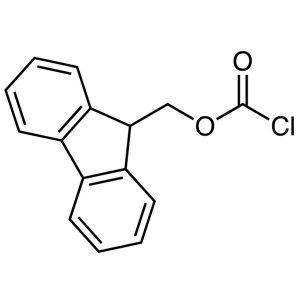
Fmoc-Cl CAS 28920-43-6 9-Fluorenylmethyl Chloro...
-
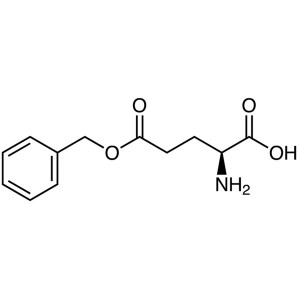
H-Glu(OBzl)-OH CAS 1676-73-9 L-Glutamic Acid γ-...
-
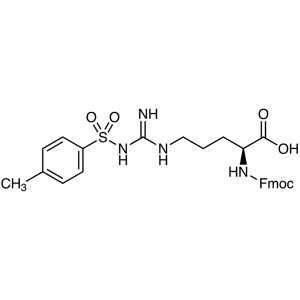
Fmoc-Arg(Tos)-OH CAS 83792-47-6 Nα-Fmoc-Nω-Tosy...
-
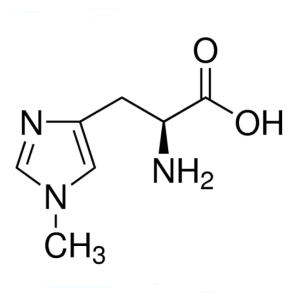
H-His(1-Me)-OH CAS 332-80-9 1-Methyl-L-Histidin...
-
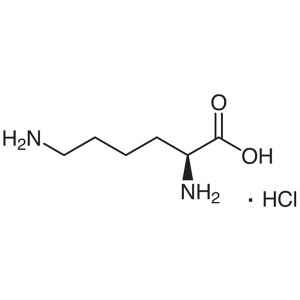
L-(+)-Lysine Monohydrochloride CAS 657-27-2 (H-...
-
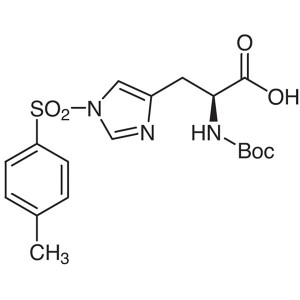
Boc-His(Tos)-OH CAS 35899-43-5 Purity >99.0% (H...


